Discover 35 hidden attractions, cool sights, and unusual things to do in Pisa (Italy). Don't miss out on these must-see attractions: Leaning Tower of Pisa, Pisa Cathedral, and Pisa Baptistery. Also, be sure to include Piazza dei Miracoli in your itinerary.
Below, you can find the list of the most amazing places you should visit in Pisa (Tuscany).
Table of Contents
Leaning Tower of Pisa
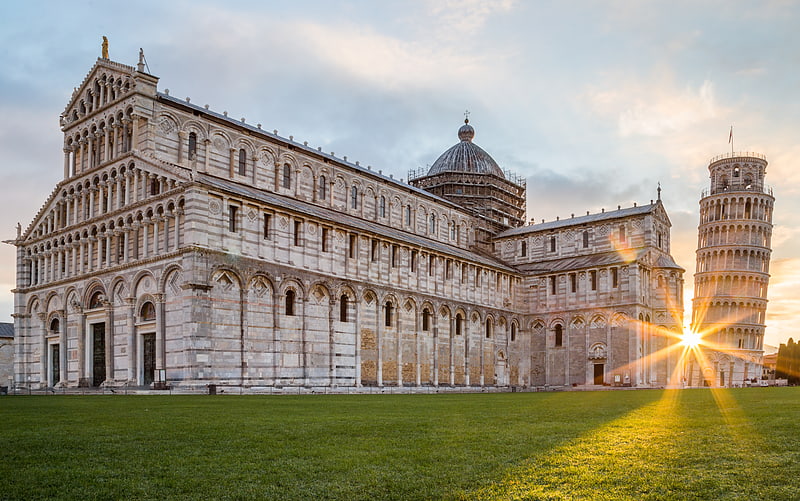
Also known as: Torre di Pisa
Ornate 14th-century tower with a tilt. The Leaning Tower of Pisa, or simply, the Tower of Pisa, is the campanile, or freestanding bell tower, of Pisa Cathedral. It is known for its nearly four-degree lean, the result of an unstable foundation. The tower is one of three structures in the Pisa's Cathedral Square, which includes the cathedral and Pisa Baptistry.
The height of the tower is 55.86 metres (183 feet 3 inches) from the ground on the low side and 56.67 m (185 ft 11 in) on the high side. The width of the walls at the base is 2.44 m (8 ft 0 in). Its weight is estimated at 14,500 tonnes (16,000 short tons). The tower has 296 or 294 steps; the seventh floor has two fewer steps on the north-facing staircase.
The tower began to lean during construction in the 12th century, due to soft ground which could not properly support the structure's weight. It worsened through the completion of construction in the 14th century. By 1990, the tilt had reached 5.5 degrees. The structure was stabilized by remedial work between 1993 and 2001, which reduced the tilt to 3.97 degrees.[1]
Address: Piazza del Duomo, 56126 Pisa
Pisa Cathedral

Also known as: Duomo di Pisa
Cathedral in Pisa, Italy. Pisa Cathedral is a medieval Roman Catholic cathedral dedicated to the Assumption of the Virgin Mary, in the Piazza dei Miracoli in Pisa, Italy, the oldest of the three structures in the plaza followed by the Pisa Baptistry and the Campanile known as the Leaning Tower of Pisa. The cathedral is a notable example of Romanesque architecture, in particular the style known as Pisan Romanesque. Consecrated in 1118, it is the seat of the Archbishop of Pisa. Construction began in 1063 and was completed in 1092. Additional enlargements and a new facade were built in the 12th century and the roof was replaced after damage from a fire in 1595.[2]
Address: Piazza del Duomo, 56126 Pisa
Pisa Baptistery

Also known as: Battistero di San Giovanni
Celebrated acoustics and Gothic sculptures. The Pisa Baptistery of St. John is a Roman Catholic ecclesiastical building in Pisa, Italy. Construction started in 1152 to replace an older baptistery, and when it was completed in 1363, it became the second building, in chronological order, in the Piazza dei Miracoli, near the Duomo di Pisa and the cathedral's free-standing campanile, the famous Leaning Tower of Pisa. The baptistery was designed by Diotisalvi, whose signature can be read on two pillars inside the building, with the date 1153.[3]
Address: Piazza del Duomo, 23, 56126 Pisa
Piazza dei Miracoli
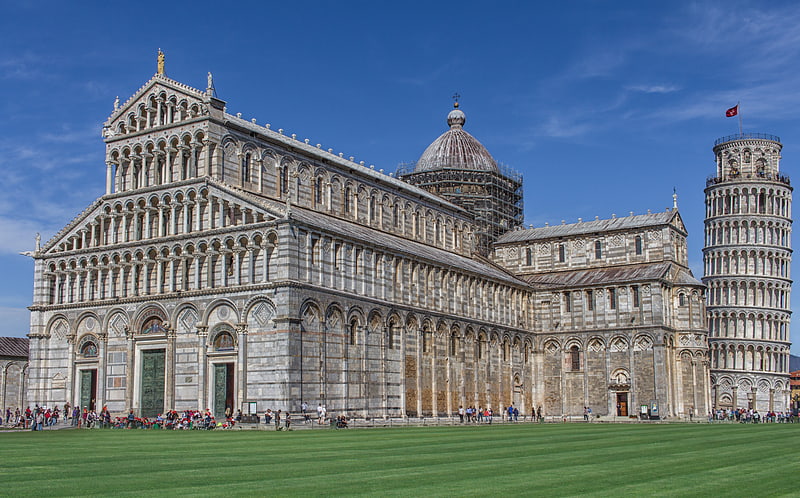
Green space that's home to leaning tower. The Piazza dei Miracoli, formally known as Piazza del Duomo, is a walled 8.87-hectare area located in Pisa, Tuscany, Italy, recognized as an important centre of European medieval art and one of the finest architectural complexes in the world. Considered sacred by the Catholic Church, its owner, the square is dominated by four great religious edifices: the Pisa Cathedral, the Pisa Baptistry, the Campanile, and the Camposanto Monumentale. Partly paved and partly grassed, the Piazza dei Miracoli is also the site of the Ospedale Nuovo di Santo Spirito, which houses the Sinopias Museum and the Cathedral Museum.
The name Piazza dei Miracoli was coined by the Italian writer and poet Gabriele d'Annunzio who, in his novel Forse che sì forse che no (1910), described the square as the "prato dei Miracoli", or "meadow of miracles". The square is sometimes called the Campo dei Miracoli ("Field of Miracles"). In 1987, the whole square was declared a UNESCO World Heritage Site.[4]
Address: Piazza del Duomo, 56126 Pisa
Camposanto Monumentale
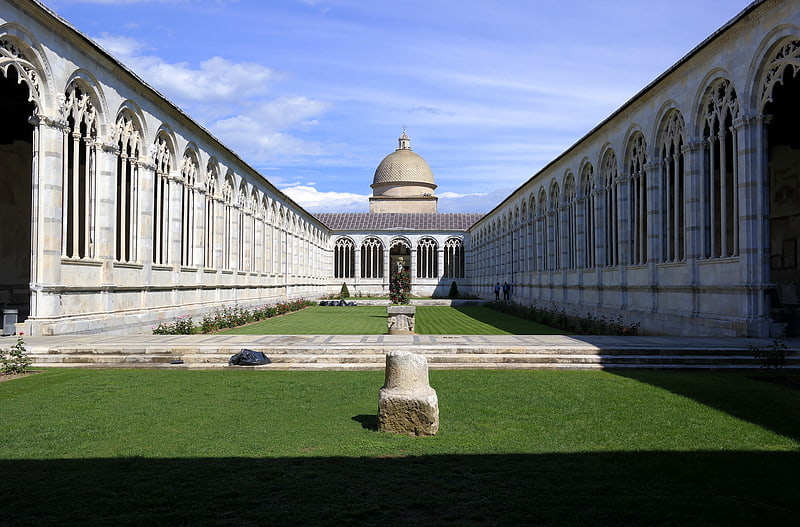
Also known as: Camposanto monumentale
Cloistered cemetery with unique frescoes. The Campo Santo, also known as Camposanto Monumentale or Camposanto Vecchio, is a historical edifice at the northern edge of the Cathedral Square in Pisa, Italy.
"Campo Santo" can be literally translated as "holy field", because it is said to have been built around a shipload of sacred soil from Golgotha, brought back to Pisa from the Third Crusade by Ubaldo Lanfranchi, archbishop of Pisa in the 12th century. A legend claims that bodies buried in that ground will rot in just 24 hours. The burial ground lies over the ruins of the old baptistery of the church of Santa Reparata, the church that once stood where the cathedral now stands.
The term "monumental" serves to differentiate it from the later-established urban cemetery in Pisa.[5]
Address: Piazza del Duomo, 56126 Pisa
Santa Maria della Spina
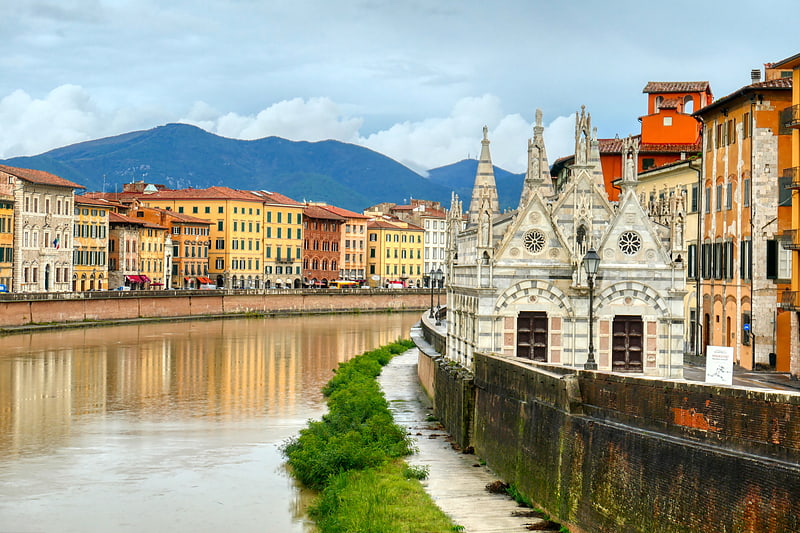
Petite church with gothic exterior. Santa Maria della Spina is a small church in the Italian city of Pisa. The church, erected around 1230 in the Pisan Gothic style, and enlarged after 1325, was originally known as Santa Maria di Pontenovo for the newer bridge that existed nearby, collapsed in the 15th century, and was never rebuilt.
The name of della Spina ("of the thorn") derives from the presence of a thorn, putatively part of the crown of thorns placed on Christ during his Passion and Crucifixion. The relic was brought to this church in 1333. In 1871 the church was dismantled and rebuilt on a higher level due to dangerous infiltration of water from the Arno river. The church was altered in the process, however, and John Ruskin, who visited Pisa in 1872, was outraged about the restoration. The church no longer houses the “thorn”. The “thorn” is now in the Chiesa di Santa Chiara, which is on show inside and can be found on Via Roma.
The church of Santa Maria della Spina has always been administered by the city, except for short interruptions in the seventeenth and eighteenth centuries when it fell to the responsibility of the local hospital.[6]
Address: Lungarno Gambacorti, 56125 Pisa
Museo delle Sinopie

Museum, Architecture, Art museum
Address: Piazza del Duomo, 56100 Pisa
Santa Chiara
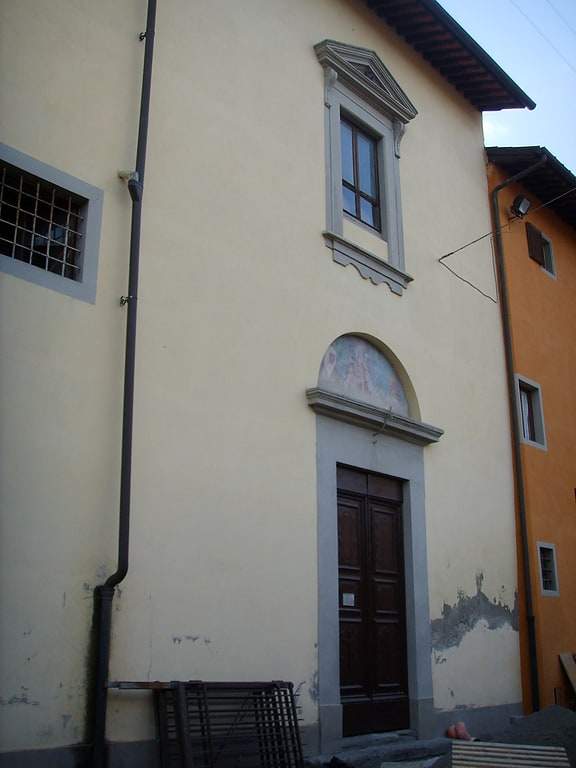
Catholic church in Pisa, Italy. Santa Chiara is a Roman Catholic church in Pisa, region of Tuscany, Italy, a few paces away from the Piazza dei Miracoli.[7]
Address: Via Roma, 67, 56126 Pisa
Giardino Scotto

Also known as: Cittadella Nuova
Park in Pisa, Italy. The Cittadella Nuova, now called the Giardino di Scotto or Giardino Scotto is an old fortress in Pisa.[8]
Address: Lungarno Leonardo Fibonacci, 56100 Pisa
Orto botanico di Pisa
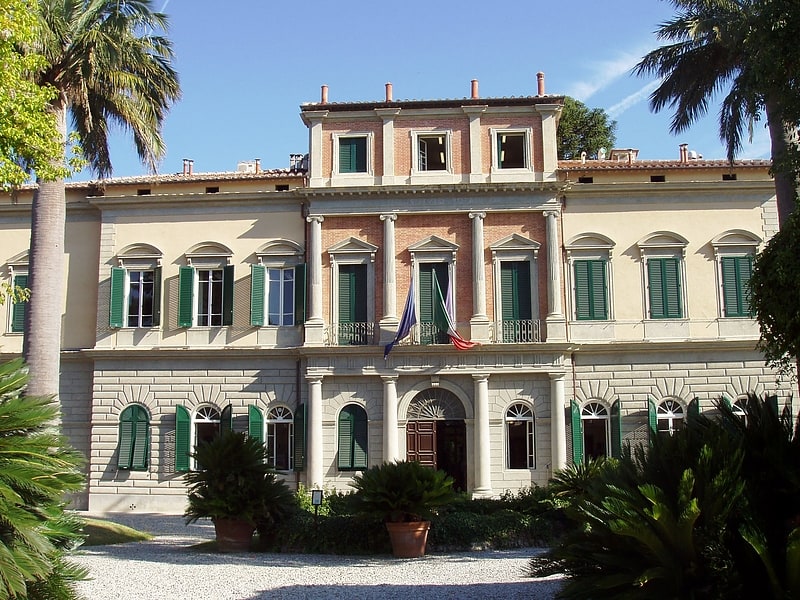
Arboretum and herbs in botanical gardens. The Orto botanico di Pisa, also known as the Orto Botanico dell'Università di Pisa, is a botanical garden operated by the University of Pisa, and located at via Luca Ghini 5, Pisa, Italy.
The garden was established in 1544 under Cosimo I de' Medici as the first university botanical garden in Europe, and entrusted to the famous botanist Luca Ghini of Imola. In 1563 the garden was relocated from its original riverside location (now the Medicean Arsenal) to one near the convent of Santa Marta, and in 1591 (under Joseph Goedenhuyze) again moved to its third and current location. From these early times, the garden has contained a gallery of natural objects (now Pisa's Museo di Storia Naturale), a library (now part of the university library), and portraits of its directors throughout the centuries. It also includes one of the earliest iron-framed hothouses built in Italy.
Today the garden is divided into sections containing the botanical school, gardens, ponds, greenhouses, and various buildings. Major collections include herb gardens and arboreta, as well as the old botany institute, built 1591–1595, with a facade ornamented with sea-shells.[9]
Address: Via Luca Ghini, 5, 56126 Pisa
San Piero a Grado

Also known as: Basilica di San Pietro Apostolo
Catholic church in Pisa, Italy. San Piero a Grado is a church in Pisa, Tuscany, Italy, in the eponymous frazione 7 kilometres west of the city center. The church is located where once was a now disappeared port of the Pisan Republic, where, according to the legend, St. Peter landed in Italy from Antiochia in 44 AD.[10]
Address: Via Vecchia di Marina, 5, 56010 Pisa
San Paolo a Ripa d'Arno
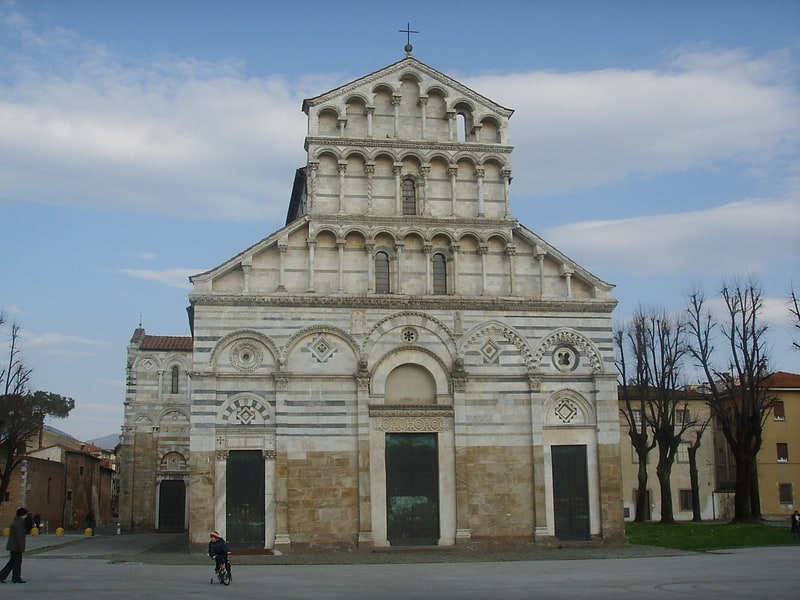
Catholic church in Pisa, Italy. San Paolo a Ripa d'Arno is a Roman Catholic church in Pisa, region of Tuscany, Italy. It is a pre-eminent example of Tuscan Romanesque church architecture. The church is also locally known as Duomo vecchio.[11]
Address: Piazza S. Paolo a Ripa D'Arno, 56125 Pisa
Museo Nazionale di San Matteo

Also known as: Museo nazionale di San Matteo
Museum in Pisa, Italy. The National Museum of San Matteo in Pisa displays works from historic ecclesiastical buildings in the city and Province of Pisa.[12]
Address: Piazza San Matteo In Soarta, 2, 56127 Pisa
Palazzo Lanfreducci
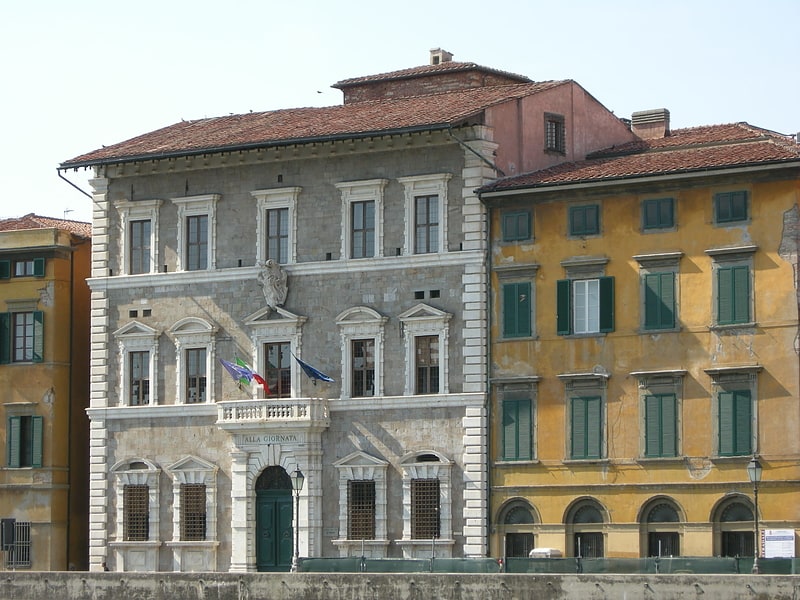
Also known as: Palazzo alla Giornata
The Palazzo Lanfreducci, also called the Palazzo Upezzinghi after 19th century owners, or the Palazzo Alla Giornata is a late-Mannerist- or early Baroque-style palace located on Lungarno Pacinotti #43, on the north bank of the Arno river, in the city of Pisa, region of Tuscany, Italy.[13]
Palazzo della Carovana

Ornate art-filled palace and university. Palazzo della Carovana is a palace in Knights' Square, Pisa, Italy, presently housing the main building of the Scuola Normale Superiore di Pisa.[14]
Address: 7 Piazza dei Cavalieri, Pisa
Statue of Cosimo I
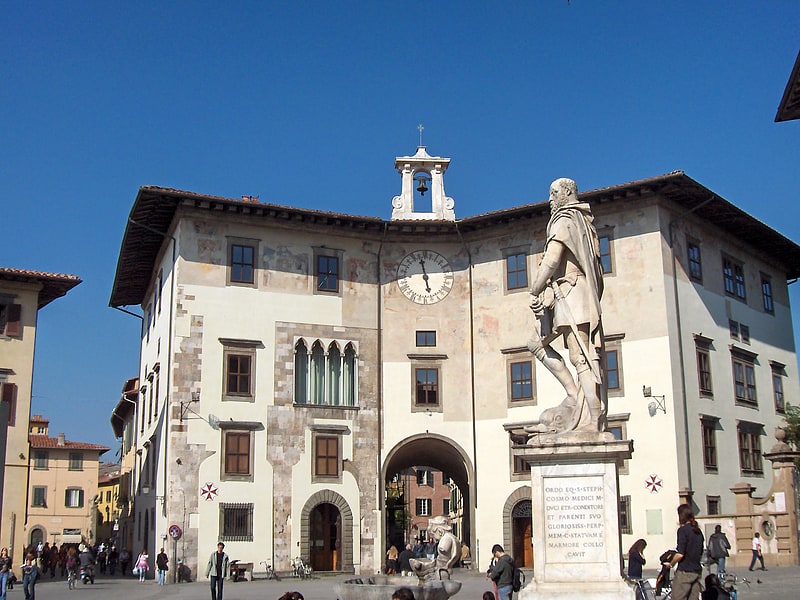
Also known as: Statua di Cosimo I
The statue of Cosimo I de' Medici stands in the middle of Knights' Square of Pisa, just in front of Palazzo della Carovana.
It was commissioned by Grand Duke Ferdinando I in 1596 to the Franco-Flemish sculptor Pietro Francavilla, who executed it in the elegant Late Mannerist tradition. The statue celebrates Ferdinando's father as the first Grand Master of the Order of the Knights of St. Stephen and is a civic symbol of the hegemony of Florence.
The Grand Duke Cosimo is represented in the robes of Grand Master, standing on a high pedestal, in the act of subduing a dolphin, symbol of his domination over the seas. The fountain, in front of the pedestal, was also erected by Francavilla. It has a basin in the form of a shell decorated with two grotesque monsters.
The statue has been damaged in the course of time.[15]
Museo della Grafica
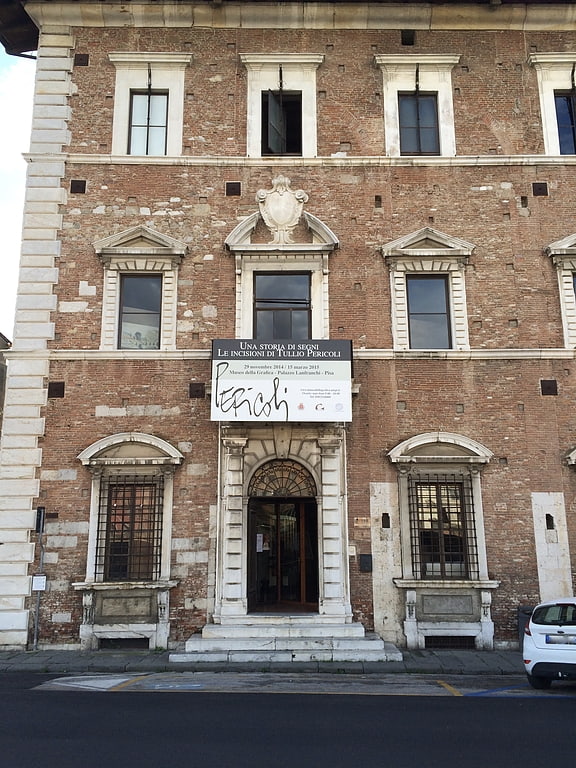
Also known as: Palazzo Lanfranchi
Palace in Pisa, Italy. The Palazzo Lanfranchi is a palace located on Lungarno Galileo Galilei #8, in the city of Pisa, region of Tuscany, Italy.[16]
Address: Lungarno Galileo Galilei 9, 56125 Pisa
Domus Galilaeana
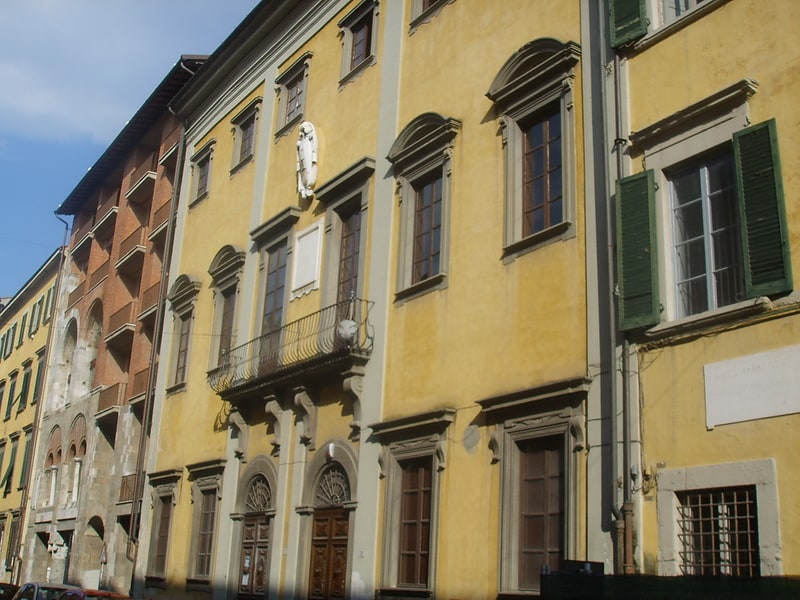
Cultural institute in Pisa, Italy. The Domus Galilaeana is a cultural and scientific institute and library, dedicated to the history of science, located in via Santa Maria #26, in Pisa, region of Tuscany, Italy. Currently, the Domus Galilaeana houses a library with more than 40,000 books and important files appertaining to scientists of the 20th century.[17]
Address: Via Santa Maria 26, 56126 Pisa
Piazza dei Cavalieri
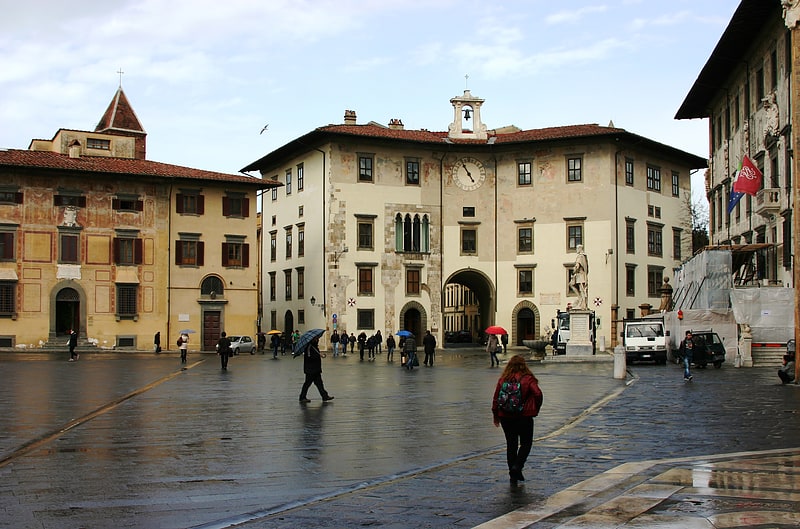
Renaissance square with Medici statue. Piazza dei Cavalieri is a landmark in Pisa, Italy, and the second main square of the city. This square was the political centre in medieval Pisa. After the middle of 16th century the square became the headquarters of the Order of the Knights of St. Stephen. Now it is a centre of education, being the main house of the Scuola Normale di Pisa, a higher learning institution part of the University.[18]
Address: Piazza Dei Cavalieri, Pisa
Palazzo dell'Orologio
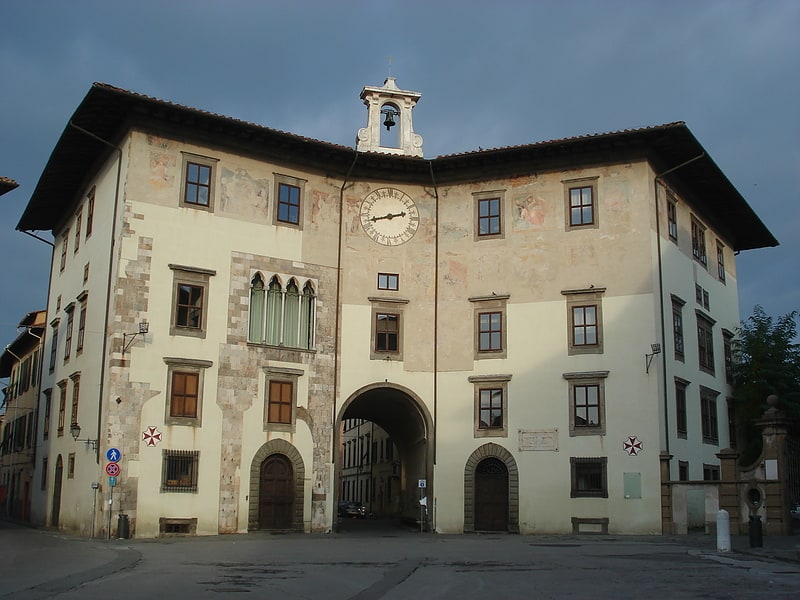
Also known as: Torre della Muda
Tower in Pisa, Italy. The Torre dei Gualandi is a former tower in Pisa, central Italy, now included in the Palazzo dell'Orologio.
It is located on the north part of the Piazza dei Cavalieri. The original tower was located on the right side of the present building. Gualandi was the name of a Pisan family that owned the tower in the 13th century.
Ugolino della Gherardesca, his sons and two grandsons were immured in the tower and starved to death in the 13th century. Dante, his contemporary, wrote about Gherardesca in his masterpiece The Divine Comedy.[19]
Baths of Nero

Also known as: Bagni di Nerone
Archaeological site in Pisa, Italy. The Baths of Nero are an archaeological site near the Porta a Lucca in Pisa, then the Roman city of Colonia Pisana. Now below street level, they are the only Roman remains still standing in the city and form a thermae complex.[20]
Address: Largo Parlascio, 26, 56127 Pisa
Santo Sepolcro
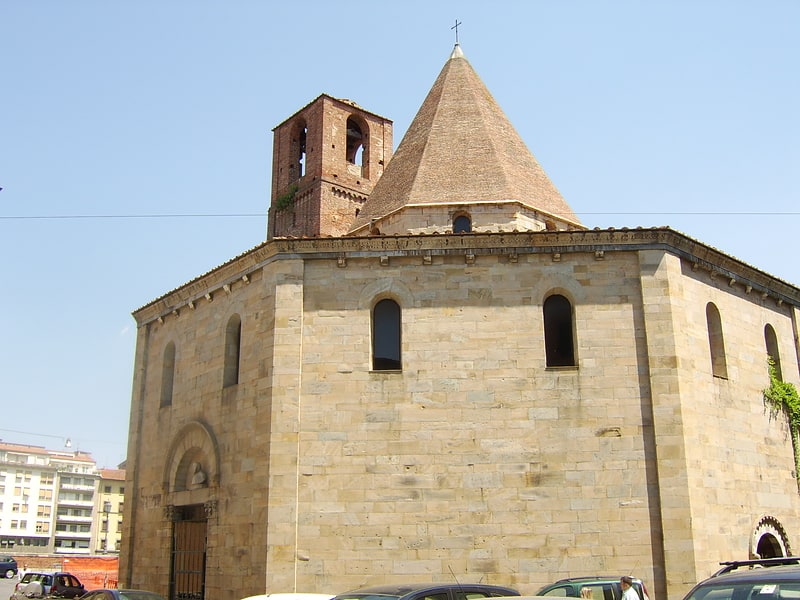
Octagonal church from the early 1100s. The Church of the Santo Sepolcro is a religious edifice in Pisa, Tuscany, Italy.
Built in the early 12th century (it is known at least from 1113), it was designed by Diotisalvi, who also designed the Baptistery of Pisa Cathedral forty years later. It has an octagonal plan and, until the 16th century, it was surrounded by a portico. The central tambour, supported by eight ogival arches, is super-elevated and is surmounted by a conic cusp.
The attribution to the Holy Sepulchre is a reference to the latter's relics which were carried in Pisa by archbishop Dagobert after his participation to the First Crusade. The structure resembles indeed the Dome of the Rock in Jerusalem, conquered by the crusaders in 1099.
The portals have decorations with animals and lions' heads in marble. The interior, restored in 1720 in Baroque style, was destroyed in the 19th century. What remains include a bust-reliquary of St. Ubaldesca (15th century) with a pail which, according to the tradition, belonged to the saint; the tombstone of Marie Mancini, Mazarin's niece; and a 15th-century panel of the Madonna with Child.
The unfinished small bell tower is in Pisane-Romanesque style, with rectangular plan.[21]
Address: Piazza S. Sepolcro, 56125 Pisa
San Sisto
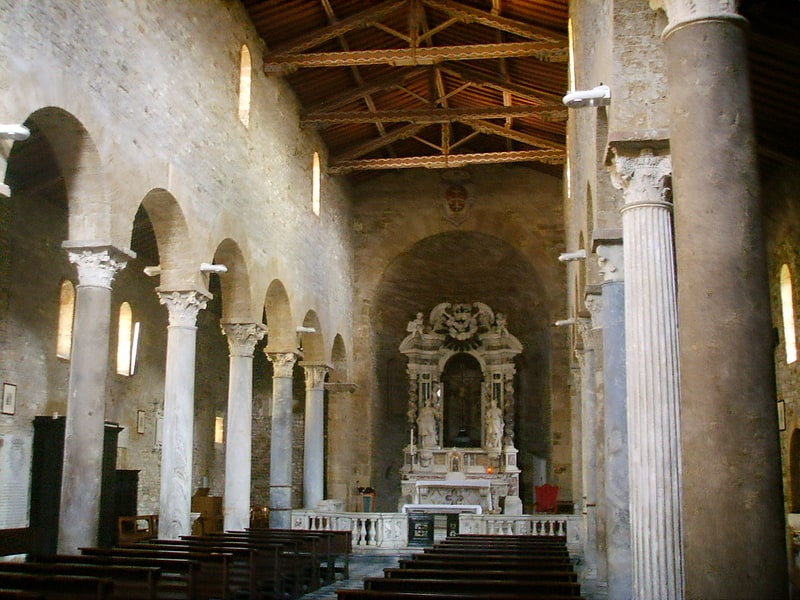
Catholic church in Pisa, Italy. San Sisto is a church in Pisa, Tuscany, Italy.
It was consecrated in 1133 but previously it had been already used as the seat of the most important notary act of the Pisan commune. It was built in a Pisane-Romanesque style in stone. The façade is divided in three parts divided by pilaster strips, with a mullioned window and arches in the upper part which continues on the whole exterior. Notable is the typical local decoration with Islamic ceramic basins from the 10th-11th centuries (copies; the original are in the Museum of St. Matthew in the city).
The interior has a nave and two aisles, divided by columns with ancient Roman capitals, with hut-shaped ceiling. It houses also an Arabic tombstone, the copy of a 14th-century Madonna with Child and the rudder of a Pisane galley (13th-14th centuries).[22]
Address: Piazza Francesco Buonamici, 1, 56126 Pisa
San Nicola
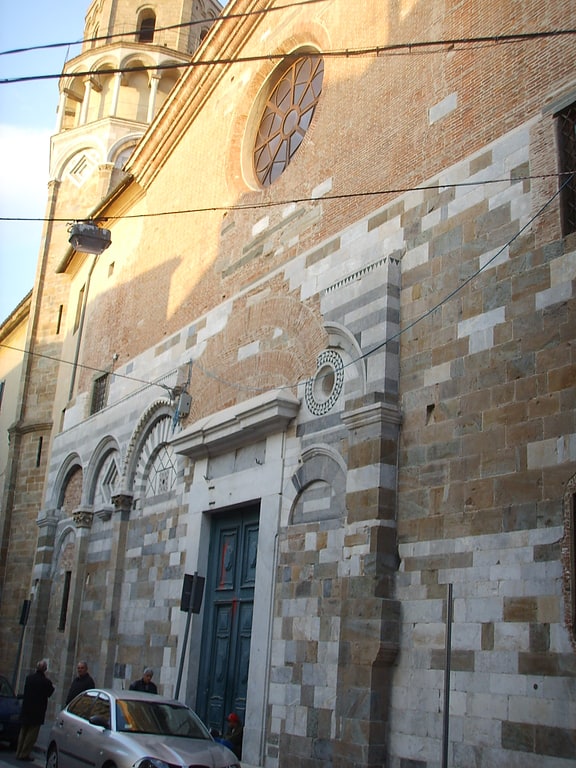
Catholic church in Pisa, Italy. San Nicola is a church in Pisa, Tuscany, Italy.[23]
Address: 2 Via Santa Maria, Pisa
San Zeno

Abbey. San Zeno is a church and a former abbey in Pisa, Tuscany, Italy.
The church is documented going back to 1029. It was part of a monastery built over pre-existing edifices, and, until the 15th century, it had also a hospital. In the 12th century it was held by the Camaldolese monks.
The church has a nave and two aisles. The façade is preceded by a portico supported by pilasters and a central columns. The second row has mullioned windows and decorations with lozenges and small circular windows, with ceramic basins by Islamic masters (11th century; the originals are in the National Museum of San Matteo).
The interior has ancient Roman capitals and traces of medieval paintings.[24]
Santa Croce in Fossabanda
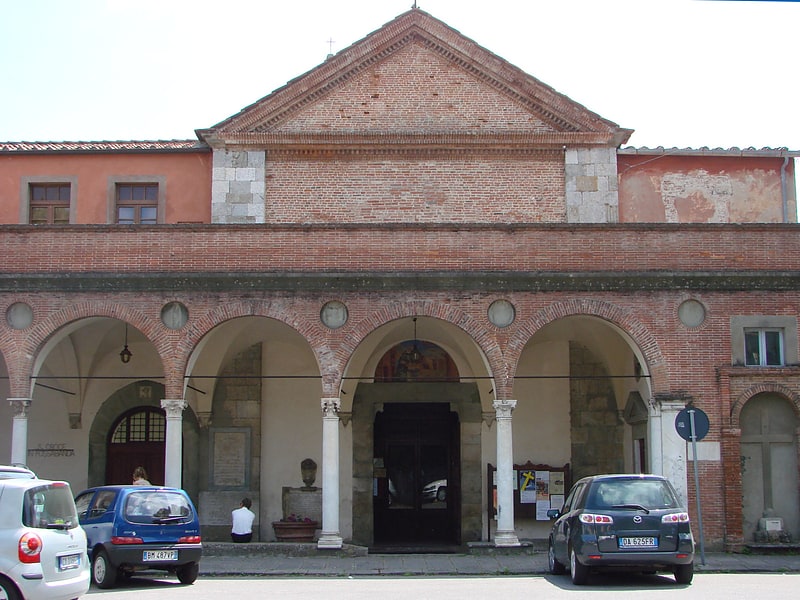
Monastery. Santa Croce in Fossabanda is a Renaissance-style Roman Catholic church and monastery in Pisa, region of Tuscany, Italy.[25]
Address: Piazza Santa Croce in Fossabanda, 12, 56124 Pisa
Santa Cristina
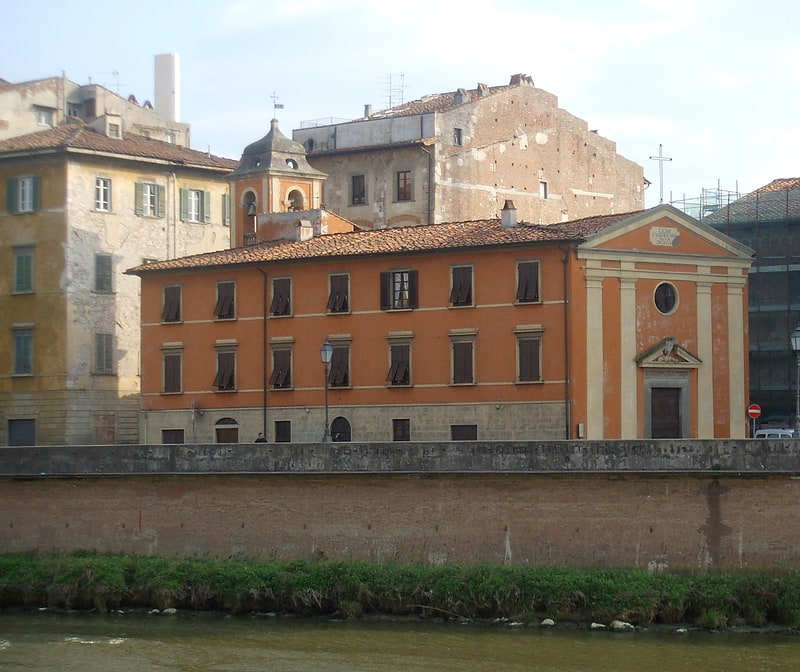
Catholic church in Pisa, Italy. Santa Cristina is a Neoclassical-style, Roman Catholic church in Pisa, region of Tuscany, Italy. It is located on the Lungarno Gambacorti.[26]
Address: Lungarno Gambacorti, 7, 56125 Pisa
Palazzo Blu

Also known as: Palazzo Giuli Rosselmini Gualandi
Museum in Pisa, Italy. Palazzo Blu is a center for temporary exhibitions and cultural activities located in 9 Lungarno Gambacorti, in the heart of the historic center of Pisa, Italy. This museum is managed by the Fondazione Palazzo Blu, and is located in the Palazzo Giuli Rosselmini Gualandi, ancient palace restored by the Fondazione Pisa. Its name comes from the blue color uncovered during an architectural recent restoration, and attributable to the taste of Russian owners who acquired the Palazzo in the eighteenth century.[27]
Address: Lungarno Gambacorti, 9, 56125 Pisa
Madonna dei Galletti

Catholic church in Pisa, Italy. The Madonna dei Galletti is a Baroque-style, Roman Catholic church in Pisa, region of Tuscany, Italy.[28]
Address: Lungarno Antonio Pacinotti, 37, 56126 Pisa
Chiesa di Santo Stefano dei Cavalieri

Building in Pisa, Italy. Santo Stefano dei Cavalieri is a church in central Pisa located on Piazza dei Cavalieri.
Construction began on 17 April 1565 in order to build a church for the Order of Knights of St Stephan, founded by the Grand Duke Cosimo de' Medici to fight Saracen piracy in the Mediterranean. The project with designs and oversight by Giorgio Vasari and David Fortini was to build a church on the site of an older church called San Sebastiano alle Fabbriche Maggiori, which dated at least to 1074. The new church on the site was consecrated by 21 December 1569. The facade, in white marble was designed by Don Giovanni de' Medici, illegitimate son of Cosimo I, with the help of Alessandro Pieroni; their designs were chosen over Vasari’s original plan. An inscription commemorates completion during the reign of Ferdinando I de' Medici.
The bell-tower, also designed by Vasari, was completed by 1572 by Giovanni Fancelli. The main altar designs were by Pier Francesco Silvani. Many alterations and additions were proposed and made over the next two centuries, including plans by Gherardo Mechini, Paolo Guidotti, Ranieri Gherardi, Torpè Donati, Alessandro Gherardesca, Florido Galli, Niccolò Matas, and Pasquale Poccianti. The final reconstruction in 1859, completed after the suppression of the order, creates the clearer interior systematization of columns we see today.[29]
Address: Piazza dei Cavalieri, 1, 56126 Pisa
Ponte della Vittoria

Arch bridge in Pisa, Italy. The Ponte della Vittoria is a bridge over the Arno in Pisa.[30]
Santi Jacopo e Filippo
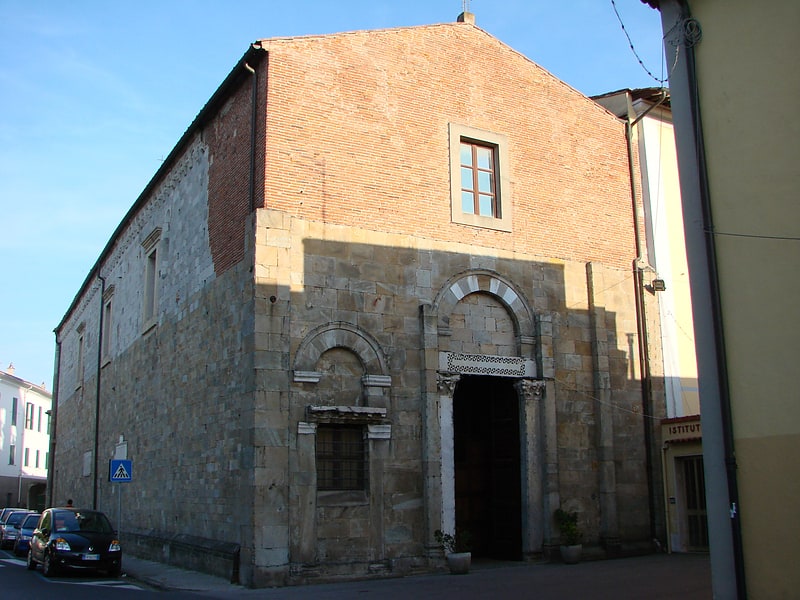
Catholic church in Pisa, Italy. Santi Jacopo e Filippo or Santi Iacopo e Filippo is an ancient church found in Via San Michele degli Scalzi in Pisa, Italy. Documents exist as belonging to an Augustinian abbey by 1110. The Romanesque architecture includes a half-finished facade. Restored in the 17th and 18th century, the interior was frescoed by Francesco and his brother Giuseppe Melani with stories of the saints.[31]
Address: Via S. Michele degli Scalzi, 48, 56124 Pisa
San Michele degli Scalzi
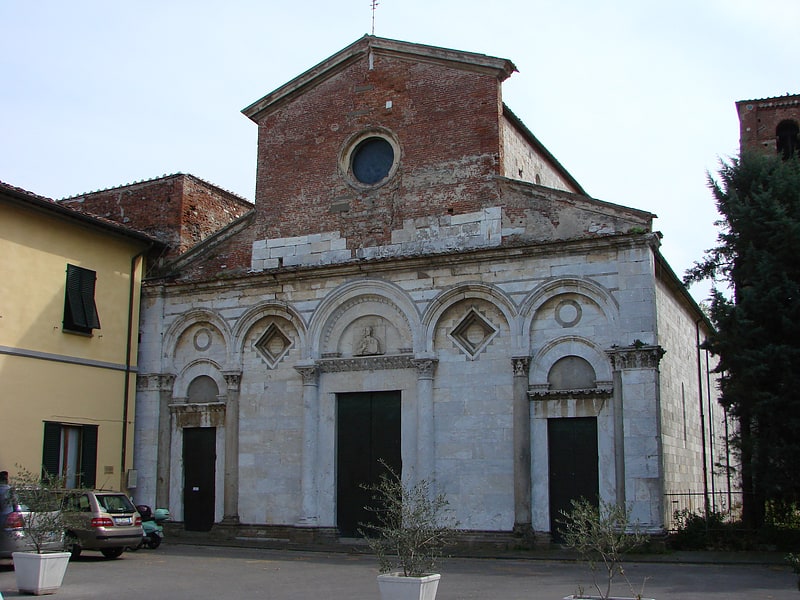
Catholic church in Pisa, Italy. San Michele degli Scalzi is a church located in Piazza San Michele degli Scalzi, in the eastern part of Pisa, Italy. It had also been known as the church of San Michele degli Scalzi in Orticaia, referring to the swampy nature of the site at the time of its founding. The term Scalzi refers to the barefoot monks linked to the church. Dating back to the 11th century, it has been restored several times in the original Romanesque style.[32]
Address: Via S. Michele degli Scalzi, 167, 56124 Pisa
Chiesa di San Frediano
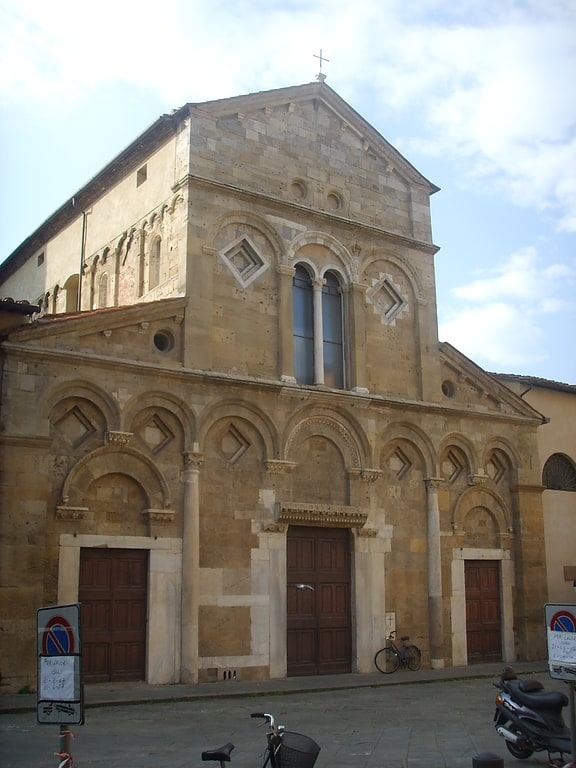
Place of worship in Pisa, Italy. San Frediano is a Romanesque-style Roman Catholic church in Pisa, Tuscany, Italy. It now functions as the official church of the University of Pisa.[33]
Address: Piazza S. Frediano, 5, 56126 Pisa
San Francesco

Catholic church in Pisa, Italy. San Francesco de' Ferri is a church in Pisa, Tuscany, Italy.
Mentioned for the first time in a document from 1233, the church was rebuilt starting from 1261 by will of archbishop Federico Visconti. The church was under the patronage of the Pisane noble families, who owned a series of private chapels for their burials; the Franciscan were limited to the administration of the cult. The works, directed by Giovanni di Simone, ended in 1270 and included also the slender bell tower.
The marble façade is from 1603. The interior was revamped in the same age, with paintings by Jacopo da Empoli, Domenico Passignano and Santi di Tito. In the transept are frescoes by Taddeo Gaddi (1342-1345), Galileo Chini (20th century) and an altar frontal by Tommaso Pisano (late 14th century).
The sacristy has frescoes by Taddeo di Bartolo (1397) with Histories of Mary, while the Capitolium Hall has frescoes by Niccolò di Pietro Gerini with Histories of the life of Christ (1392). The rectangular cloister is from the 14th century.
After a period as military barracks, the church was declared national monument in 1893. The church was once home to Giotto's Stigmata of St. Francis and Cimabue's Maestà, both robbed by the French in the 1810s and now housed at the Louvre Museum.[34]
Address: Piazza San Francesco 4, 56127 Pisa